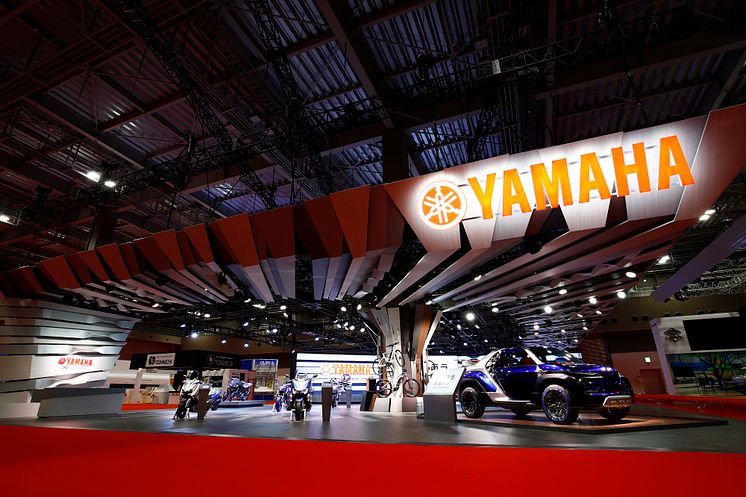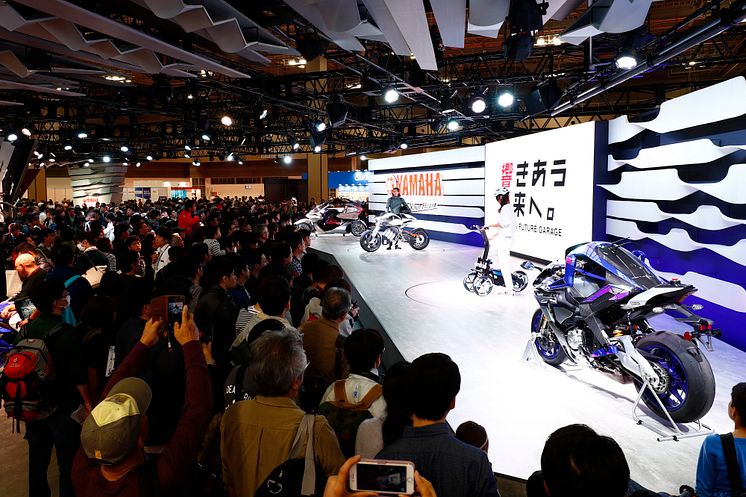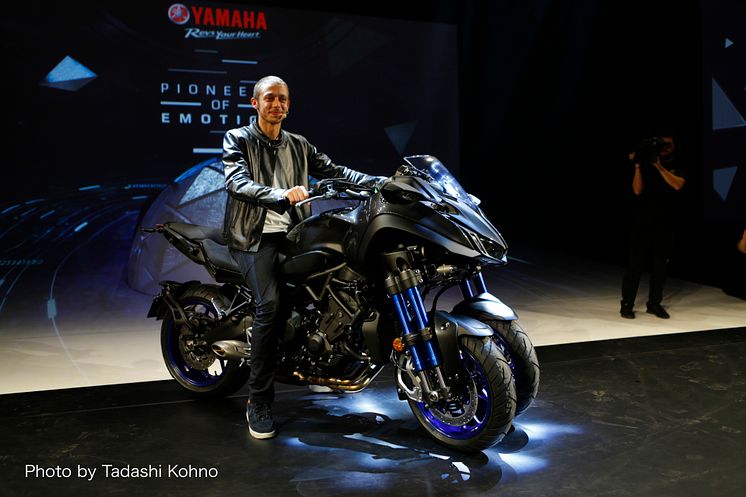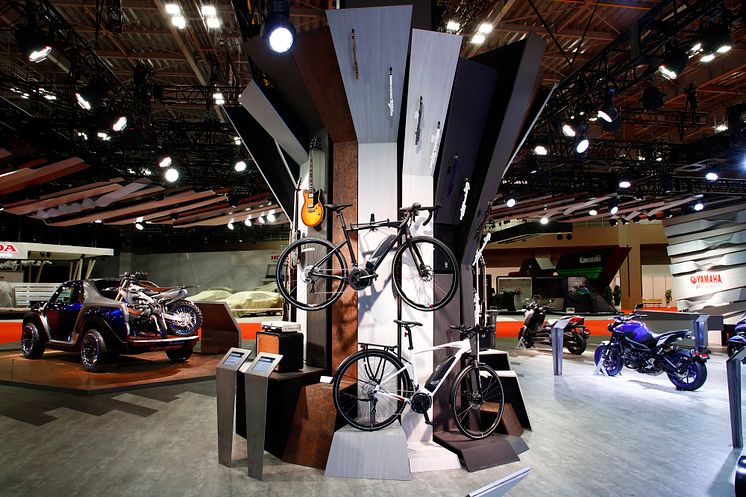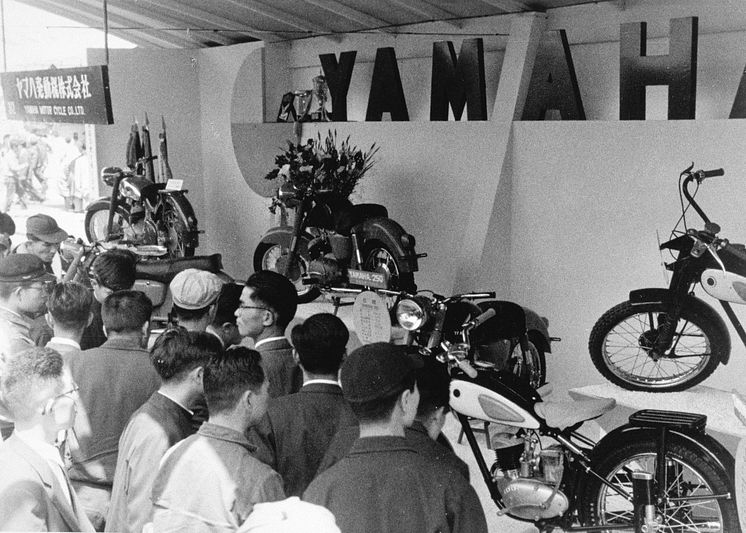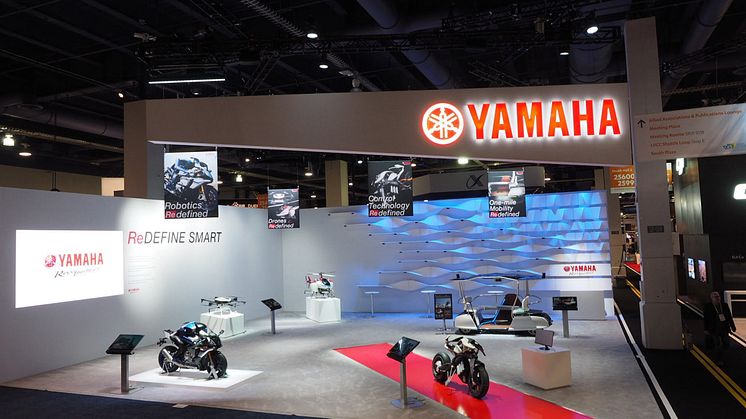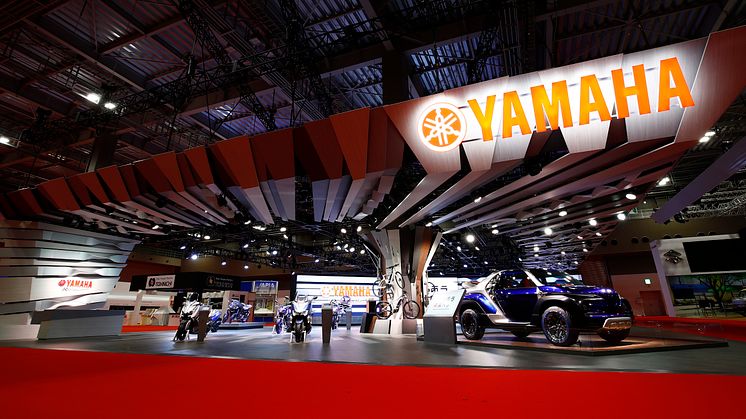
News -
Resonate the Future: The Yamaha Booth at the 2017 Tokyo Motor Show - Yamaha Motor Monthly Newsletter(Dec.15, 2017 No.60)-
When the 45th Tokyo Motor Show 2017 opened to the public on October 28, 2017, Yamaha Motor was one of many exhibitors that took this prominent event as an opportunity for corporate communication and to show the directions in which the company will be moving forward.
With the theme of “Yamaha Future Garage: Resonate the Future,” the Yamaha booth had a total of 20 models on display, including six world premiere models. The visitors crowding to the booth were presented with the “ever-growing world of personal mobility” vision unique to Yamaha, a specialist in small vehicles for personal mobility.
In this issue, we introduce the responses of visitors and the impact of the show while looking at the main models on display, their aims and intended messages.
Resonate and Grow: The Future of Personal Mobility
As expressed in our “Revs your Heart” brand slogan, Yamaha Motor strives for Monozukuri (creating products with an emphasis on craftsmanship and excellence) and corporate activities that offer exceptional value and experiences that enrich the lives of people all over the world. One of these objectives is to create a “growing world of personal mobility.” Yamaha has worked to further develop technologies that not only make mobility more fun, but also lead to vehicles that enrich people’s lifestyles and are more user-friendly, socially responsible and eco-friendly. To that end, Yamaha has launched products in a wide range of fields over the years, from motorcycles, scooters and Leaning Multi-Wheelers (LMWs) to electrically power-assisted bicycles, Recreational Off-highway Vehicles (ROVs), snowmobiles, outboard motors and boats. Going forward, we want to pour even more passion and energy into building an “ever-growing world of personal mobility.”
To express this uniquely Yamaha vision, our booth at the 45th Tokyo Motor Show 2017 was created as a “garage” connecting the present and future of our Monozukuri. We introduced a rich variety of products and projects unified by our exclusive Jin-Ki Kanno development ideal.
To begin, let’s introduce MOTOROiD, an experimental proof-of-concept model developed to explore the idea of personal mobility that “resonates” harmoniously with the rider. Employing Yamaha’s exclusive AMCES (Active Mass CEnter Control System) attitude-control tech-nology, MOTOROiD can remain upright unassisted at a standstill or in low-speed motion—two inherently highly unstable states with a two-wheeled vehicle. It is also equipped with image recognition technology and artificial intelligence (AI) that enables it to recognize its owner and respond to movement commands autonomously. Also, the machine mounts other features like a haptic human-machine interface (HMI) that works to provide a greater sense of unity between rider and machine as it contacts the rider’s waist and chest area, as if the owner is being embraced by the vehicle. These contact points are aimed at a more intuitive form of feedback and interaction between the rider and machine, as if it were a living, thinking entity. In the words of the one of the machine’s chief developers, “I think part of the fun of motorcycles is how you control them. What form would a motorcycle take if we maximized that aspect alone? MOTOROiD is an experimental model born in that search.”
Another prominent exhibit at the show was our autonomous motorcycle-riding robot, MOTOBOT. In contrast to MOTOROiD, the goal of MOTOBOT is to explore controlling the machine at high speeds from a rider standpoint. First introduced at the Tokyo Motor Show in 2015, the updated MOTOBOT Version 2 was on display this year.

| There were crowds of visitors at the Yamaha booth every day that wanted to see MOTOROiD, MOTOBOT Ver. 2 and the Tritown in action with their own eyes. |
Although it hasn’t yet achieved its goal of besting the lap time set by MotoGP star Valentino Rossi, it has achieved the objective of exceeding 200 km/h on a racetrack riding an unmodified YZF-R1M. The robot itself was introduced at the show together with a video depicting its progress to date. In the future, the new knowledge gained through this project regarding the relationship between rider inputs and machine behavior will contribute to the development of products delivering greater Kando* and also reveal new possibilities for developing automated riding/driving technology across a variety of vehicles. Yamaha also unveiled its third model in its ongoing research of cars with a uniquely Yamaha approach. Following the Motiv displayed in 2013 and the Sports Ride Concept model shown in 2015, the Cross Hub Concept was unveiled at this year’s show as a sport-utility vehicle aimed at connecting the “active” and “urban” in the lifestyles of Yamaha enthusiasts.
*Kando is a Japanese word for the simultaneous feelings of deep satisfaction and intense excitement that we experience when we encounter something of exceptional value.
Technological Development:Moving Step by Step to Turn Dreams into Reality
Another model that excited show visitors was the new NIKEN large-displacement Sport LMW model. Expanding on the technology already proven in use with the Tricity, the NIKEN is powered by an in-line 3-cylinder engine and features dual-tube front forks for each of its two front wheels.

| At EICMA, the 2018 release of the NIKEN Sport LMW was announced. This is a good example of a concept model initially unveiled at the Tokyo Motor Show later becoming a production model with subsequent R&D. |
Carrying on the concept of the MWT-9 prototype displayed at the 2015 Tokyo Motor Show, the NIKEN achieves excellent performance for spirited and sporty riding on various road surfaces and the capability to freely carve through the continuous corners of winding roads. It was officially announced as a production model at the EICMA motorcycle show in Italy shortly after the Tokyo Motor Show, immediately triggering a big response from the market. Other models on display using Yamaha’s LMW technology were the Tritown, an electric vehicle ridden standing up for short-distance transportation, and the MWC-4, a unique 4-wheeled leaning model.
The production motorcycles displayed at the Yamaha booth included the latest models of the MT Series and MAX Series popular worldwide, as well as the all-new Star Venture transcontinental tourer. Among this flagship tourer’s features to make the journey more enjoyable are an infotainment system compiling internet-based communications and onboard navigation, an audio system designed to create the best possible acoustic environment for the rider and passenger and a small electric motor to aid in maneuvering the bike forward or backward when parking. Also on display were four new electrically power-assisted sport bicycles. E-bikes were pioneered by Yamaha and are continuing to grow in popularity, particularly in Europe. With this array of products on display, the booth gave visitors a clear picture of the diversity of the unique style of Yamaha.
“One notable aspect of this year’s Tokyo Motor Show was the increased number of young people and women among show visitors. Amid this trend, we recorded the highest number of visitors to our booth since 2011, surpassing 350,000 in all,” comments a Yamaha representative involved in the booth’s planning and operations. “The videos of the stage demonstrations we did for the Tritown and MOTOROiD, and other coverage at the press conference prior to the show’s public opening were widely viewed and shared online, and we think the new interest and expectations they generated were a major factor in the higher visitor numbers. It was very gratifying for us to see such a broad demographic—men, women and children of all ages—make their way to our booth and enjoy the varied offerings of Yamaha’s growing world of personal mobility. The high level of visitor interest and approval of what we had on display was also evident in the large number of questions and comments made to our staff on hand for display explanations. The growing interest we’ve seen at large in Yamaha’s robotics and LMW technology in particular is clear from the large amount of coverage we received from both domestic and foreign media, and this solid response is a big asset for us as we look toward the future,” he concludes.

| In addition to our latest production motorcycles, the wide variety in Yamaha’s “growing world of personal mobility” was clear to see with the 4-wheeled MWC-4, electrically power-assisted bicycles and more. |
Jin-Ki Kanno: Building on Our Monozukuri Heritage
The first Tokyo Motor Show was held in 1954, one year before Yamaha Motor was founded. At the time, Japan was still in the midst of recovering from the devastation of World War II, and the exhibits at that inaugural show were still mainly trucks and motorcycles for transporting cargo or making deliveries.

| The Yamaha booth at the 1957 Tokyo Motor Show (the All-Japan Motor Show at the time) exhibited the recently released YD-1 and YC-1 alongside the YA-1. |
Nonetheless, the expectations of the organizers and exhibitors for the nascent domestic automotive industry to recover, catch up to and exceed the world’s top makers, as well as the hopes and dreams of the public for a better future, combined to bring 547,000 visitors to the show over its ten-day run. In 1964, carmakers from overseas joined for the first time and the show rapidly grew and transformed into an international event.
Yamaha Motor first entered from the 3rd Tokyo Motor Show in 1956. Being an exhibitor in those days was more about showing off the latest offerings in the lineup, but Yamaha later took on a bolder approach worthy of the trade show spirit in 1971, displaying the GL750 prototype powered by a 2-stroke liquid-cooled 4-cylinder engine with fuel injection. This was followed by the prototype RZ201 in 1972 that mounted a rotary engine.
Amid these developments, Yamaha’s Monozukuri began to focus increasingly on the perceptions and sensitivities of the rider, which led to the birth of several top-selling models that went against what was considered the mainstream in their respective eras. These included the RZ250 and RZ350 (RD250/350LC) sport bikes that packaged the best of what a 2-stroke engine had to offer, the VMAX that boasted awesome acceleration and standout styling, and the FZ750, a product of Yamaha’s quest to synergistically enhance both engine performance and handling. What was taking shape was a focus on the seductive exhilaration of being one with the machine that is shared as a baseline when quantifying and integrating it into a Yamaha’s performance. This process was expressed as Jin-Ki Kanno in 1997 and made the theme of that year’s Yamaha booth at the Tokyo Motor Show. The model Yamaha introduced to the world as embodying that ideal was the first-generation YZF-R1.
From then on, Yamaha began consistently using the term for exhibit themes or as an element woven into some of the products displayed, much like MOTOROiD at this year’s show. For Yamaha, the Tokyo Motor Show represents an opportunity for us to reexamine our origins and use that as a springboard for the next steps we take towards innovation and the future.

*This is a dedicated e-mail providing Yamaha Motor PR materials for viewing by media journalists.
We request that you refrain from using the materials and photographs on this e-mail for purposes other than media reporting.
